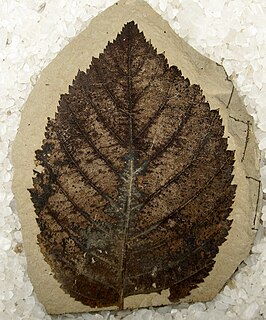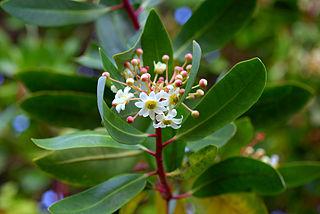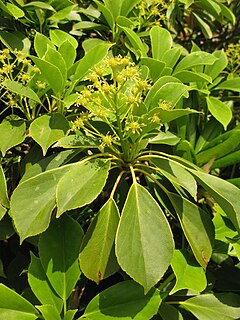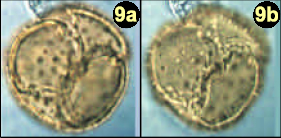
Pollen is a powdery substance produced by seed plants. It consists of pollen grains, which produce male gametes. Pollen grains have a hard coat made of sporopollenin that protects the gametophytes during the process of their movement from the stamens to the pistil of flowering plants, or from the male cone to the female cone of gymnosperms. If pollen lands on a compatible pistil or female cone, it germinates, producing a pollen tube that transfers the sperm to the ovule containing the female gametophyte. Individual pollen grains are small enough to require magnification to see detail. The study of pollen is called palynology and is highly useful in paleoecology, paleontology, archaeology, and forensics. Pollen in plants is used for transferring haploid male genetic material from the anther of a single flower to the stigma of another in cross-pollination. In a case of self-pollination, this process takes place from the anther of a flower to the stigma of the same flower.

Hickory is a common name for trees composing the genus Carya, which includes around 18 species. Five or six species are native to China, Indochina, and India (Assam), as many as twelve are native to the United States, four are found in Mexico, and two to four are native to Canada. A number of hickory species are used for products like edible nuts or wood.

Paleobotany, which is also spelled as palaeobotany, is the branch of botany dealing with the recovery and identification of plant remains from geological contexts, and their use for the biological reconstruction of past environments (paleogeography), and the evolutionary history of plants, with a bearing upon the evolution of life in general. A synonym is paleophytology. It is a component of paleontology and paleobiology. The prefix palaeo- means "ancient, old", and is derived from the Greek adjective παλαιός, palaios. Paleobotany includes the study of terrestrial plant fossils, as well as the study of prehistoric marine photoautotrophs, such as photosynthetic algae, seaweeds or kelp. A closely related field is palynology, which is the study of fossilized and extant spores and pollen.

Winteraceae is a primitive family of tropical trees and shrubs including 93 species in five genera. It is of particular interest because it is such a primitive angiosperm family, distantly related to Magnoliaceae, though it has a much more southern distribution. Plants in this family grow mostly in the southern hemisphere, and have been found in tropical to temperate climate regions of Malesia, Oceania, eastern Australia, New Zealand, Madagascar and the Neotropics, with most of the genera concentrated in Australasia and Malesia. The five genera, Takhtajania, Tasmannia, Drimys, Pseudowintera, and Zygogynum s.l. all have distinct geographic extant populations. Takhtajania includes a single species, T. perrieri, endemic only to Madagascar, Tasmannia has the largest distribution of genera in Winteraceae with species across the Philippines, Borneo, New Guinea, Eastern Australia, and Tasmannia, Drimys is found in the Neotropical realm, from southern Mexico to the subarctic forests of southern South America, Pseudowintera is found only in New Zealand, and Zygogynum has species in New Guinea and New Caledonia.

Coriaria is the sole genus in the family Coriariaceae, which was described by Linnaeus in 1753. It includes 14 species of small trees, shrubs and subshrubs, with a widespread but disjunct distribution across warm temperate regions of the world, occurring as far apart as the Mediterranean region, southern and eastern Asia, New Zealand, the Pacific Ocean islands, and Central and South America.

Microcachrys tetragona, the creeping pine or creeping strawberry pine, is a species of dioecious conifer belonging to the podocarp family (Podocarpaceae). It is the sole species of the genus Microcachrys. The plant is endemic to western Tasmania, where it is a low shrub growing to 1 m tall at high altitudes. Its leaves are scale-like, arranged in opposite decussate pairs, superficially resembling those of the unrelated Diselma archeri (Cupressaceae). It shares the common name Creeping pine with several other plants. Females produce tiny, red, edible berries in summer.

Trochodendron is a genus of flowering plants with one living species, Trochodendron aralioides, and six extinct species known from the fossil record. It was often considered the sole genus in the family Trochodendraceae, though botanists now also include the distinct genus Tetracentron in the family.

Droseridites is a genus of extinct plants of possible droseracean or nepenthacean affinity. It is a form taxon known only from fossil pollen. Species assigned to this genus originate from numerous regions of the world, including Europe, India, Egypt, the Arabian Peninsula, and the Kerguelen Islands.
Droserapollis is a genus of extinct plants in the family Droseraceae. It is a form taxon known only from fossil pollen.

Pinus morrisonicola, is a species of conifer in the family Pinaceae. It is a large tree, up to 15–25 m (50–80 ft) high and 1.2 m (4 ft) in diameter. The trunk is often crooked. Needles are in bundles of five. Mature cones are large, to 10 cm (4 in) long and 4–5 cm (1.6–2.0 in) wide.

Pinanga tashiroi is a species of palm tree in the family Arecaceae. It is a small tree, up to 5 m (16 ft) tall, swollen at base. It is a critically endangered species.

Fagus hayatae, also known as Taiwan beech, is a species of beech tree. It can grow 20 metres (66 ft) tall.It is the only beech species native to Taiwan. While IUCN reports it, as endemic to Taiwan, "Flora of China" and "Flora of Taiwan" also report it from China; "Flora of China" reports a wide but discontinuous mainland distribution between Sichuan in the southwest to Zhejiang in the east.
Lithocarpus dodonaeifolius is a species of tree in the family Fagaceae. L. dodonaeifolius is a medium-sized tree, up to 9 m (30 ft) tall. It is endemic to Taiwan and only occurs in the Hengchun Peninsula in the extreme south of the country. It grows in mixed mesophytic forests at altitudes of 500–1,500 m (1,600–4,900 ft).
Lithocarpus formosanus is a species of tree in the family Fagaceae. L. formosanus is a medium-sized tree with crooked trunk and many branches. It is endemic to Taiwan as it only occurs in the Hengchun Peninsula in the extreme south of the country. It grows in mixed mesophytic forests at altitudes of 100–500 m (330–1,640 ft). Only single population of fewer than 50 individuals survives.

Cinnamomum osmophloeum, commonly known as pseudocinnamomum or indigenous cinnamon, is a medium-sized evergreen tree in the genus Cinnamomum. It is native to broad-leaved forests of central and northern Taiwan.
Rubus lambertianus is a flowering plant species in the genus Rubus found in Southern China, Taiwan, Japan, and Thailand. Its ploidy is 2n = 4X (tetraploid). The ellagitannins lambertianin A, B, C and D can be found in R. lambertianus.

Daphniphyllum macropodum is a shrub or small tree found in China, Japan and Korea. Like all species in the genus Daphniphyllum, D. macropodum is dioecious, that is male and female flowers are borne on different plants. The timber is used in China in construction and furniture making. It is grown as an ornamental plant, chiefly for its foliage.

Neolitsea aciculata is a species of small evergreen tree in the family Lauraceae. It is found in Japan and Taiwan. In Taiwan, it grows often in mixed coniferous and broad-leaved forests in valleys throughout the island.

Betula leopoldae is an extinct species of birch in the family Betulaceae. The species is known from fossil leaves, catkins, and inflorescences found in the early Eocene deposits of northern Washington state, United States, and similar aged formations in British Columbia, Canada. The species is placed as basal in Betula, either as a stem group species, or an early divergent species.
Xylopia discreta is a species of plant in the Annonaceae family. It is native to Brazil, Colombia, French Guiana, Guyana, Suriname, and Venezuela. Carl Linnaeus the Younger, the botanist who first formally described the species using the basionym Unona discreta, named it after its purple, aromatic fruit which set it apart from other members of the family.













